You actually can. In Sicily.
It is called the “Medagliere” and it occupies the basement of the Archaeological Museum of Siracusa, on the island’s south-eastern tip.
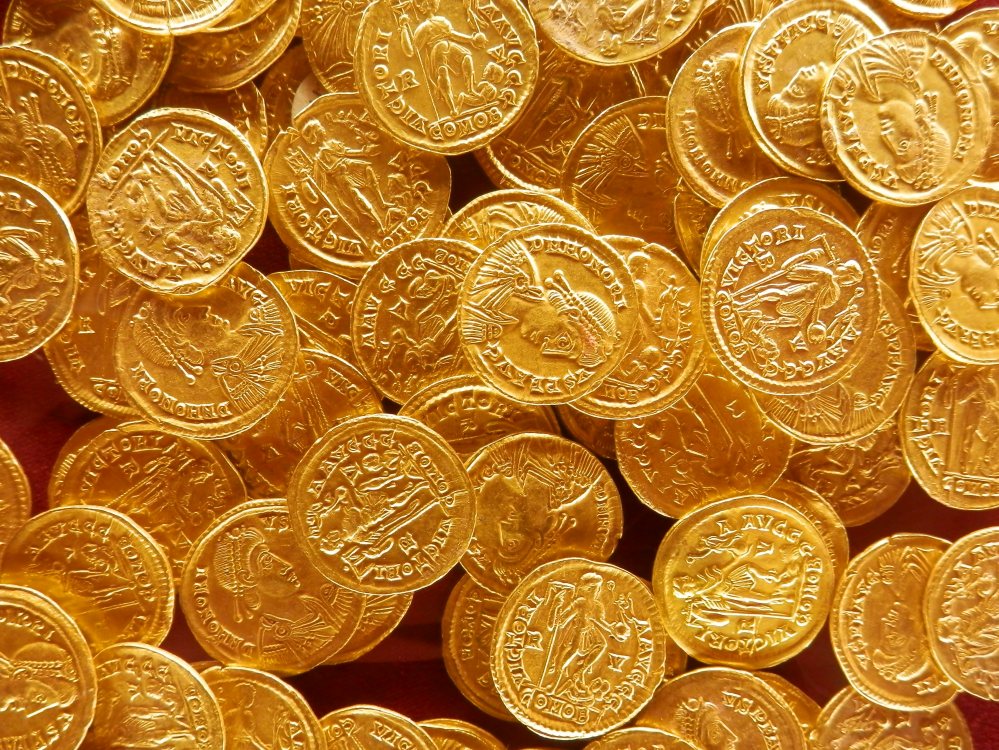
You get an adrenaline rush just walking through the door. It is solid metal about four feet thick, with iron bars that poke out in all directions and penetrate into reinforced concrete walls. You can’t lock a door like that with a key, of course: it is operated with the kind of wheel you would use to steer a ship.
Sorry I forgot to photograph it. I was too distracted by all the coins and bling inviting me inside…
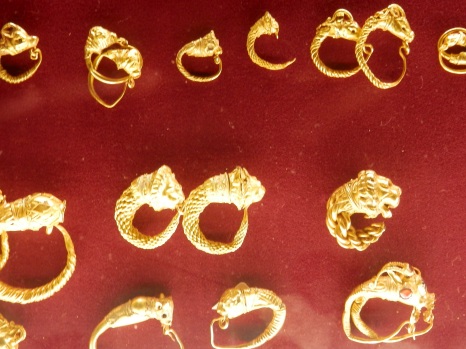
The reason the contents of this vault are priceless is not just sheer monetary value (though that is astronomically high) but because most of the coins are two to two-and-a-half thousand years old, and many of them are irreplaceable. They date from the Archaic age and the Classical era, plus some Medieval treasures.

There is also a small jewellery section containing Etruscan gold work, which is so fine that nobody has ever been able to figure out how on earth they made it… not even by cheating and employing modern equipment which the Etruscans didn’t have.
This is an Etruscan pendant. You see those tiny gold grains on the eagle’s body? Each one is the size of a grain of sand, and its contact point with the main part of the eagle is tiny: it is a perfect sphere. You cannot cast something with an undercut like that, and you cannot make a gold grain and then “stick” it onto the body of the eagle without melting the whole thing.
As I said, these things are priceless and irreplaceable.

I loved the Medieval jewellery, too – which has inspired some highly covetable bling by Sicilian fashion duo Dolce & Gabbana.
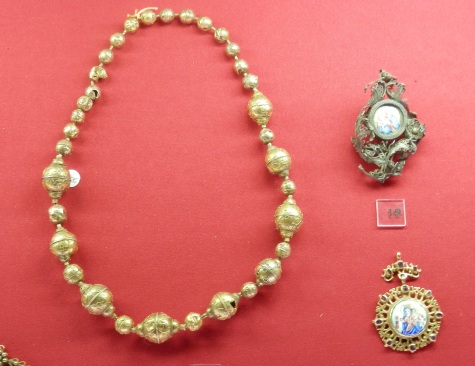
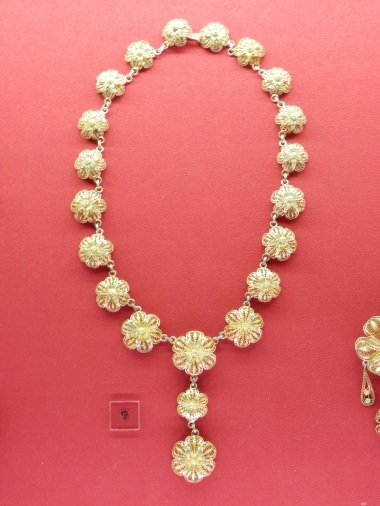

The museum started its coin collection in the 19th century, but the core of the modern display was put together by an enthusiastic numismatics expert called Luigi Bernabò Brea in the 1950s. Since then, the museum collection has grown with the addition of some important private collections and some impressive donations.
I have to admit that, until visiting this museum, had always suspected numismatics was probably a bit dull. That was before I met its charming and absolutely fascinating curator, Rosalba Riccioli.
She gives all her visitors a personal guided tour, telling the stories behind the exhibits and describing the history of the use of money in a narrative which unfolds like a series of fairy tales and adventures.
These coins below are tetradrachms, with the value of 4 drachmas. They show four dolphins with the goddess Arethusa profile. Dolphins were highly respected as mans best friend among the Greek islanders and sailors. Stories survive of them saving men who fell overboard by pushing them back to their boats. Arethusa was a water nymph who, according to legend, fled her home beneath the sea and emerged in Syracuse in the form of a freshwater spring.
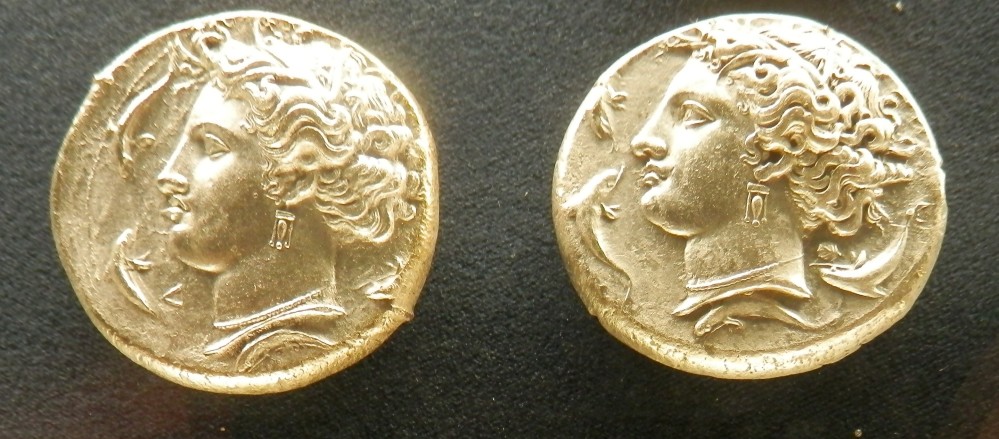
On the reverse, the same coins show a war chariot being greeted by Victory (Nike), the flying goddess, and beneath, a set of armour including helmet, cuirass (breastplate) and greaves (to protect shins).
The degree of fine detail on the coins was staggering. The diameter of these coins in the photo (below) was 2 centimetres (less than one inch).

Coins in ancient times were made of gold or silver, but most often made of electrum, which is a blend of silver and gold. Modern gold jewellery is blended with a variety of base metals, but electrum is elemental gold and silver, so more valuable.
These coins were not just money but exquisite works of art, and the few men with the skill to make them were recognised as artists, whose names are known to this day. The coins below, were made by Eukleidas, one of the leading artists of ancient Greek syracuse.
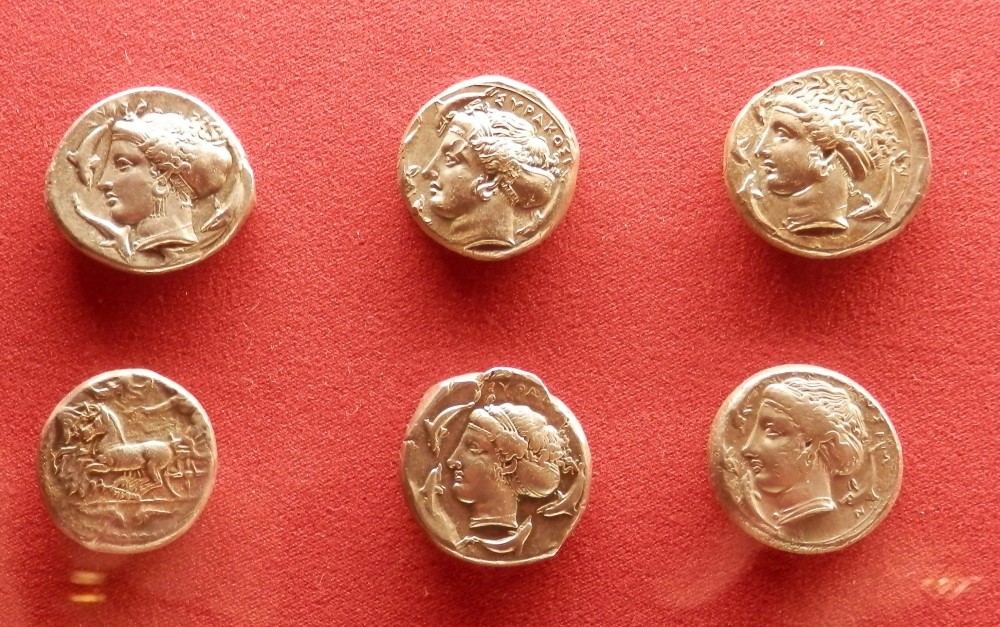
Each city in ancient times had its own coinage. How widely it was accepted was a direct reflection of how much people trusted that city’s government to make sure it was not diluted with base metal, or below its official weight. In the ancient world, the coinage of Siracusa and Athens were by far the two most widely accepted and trusted.
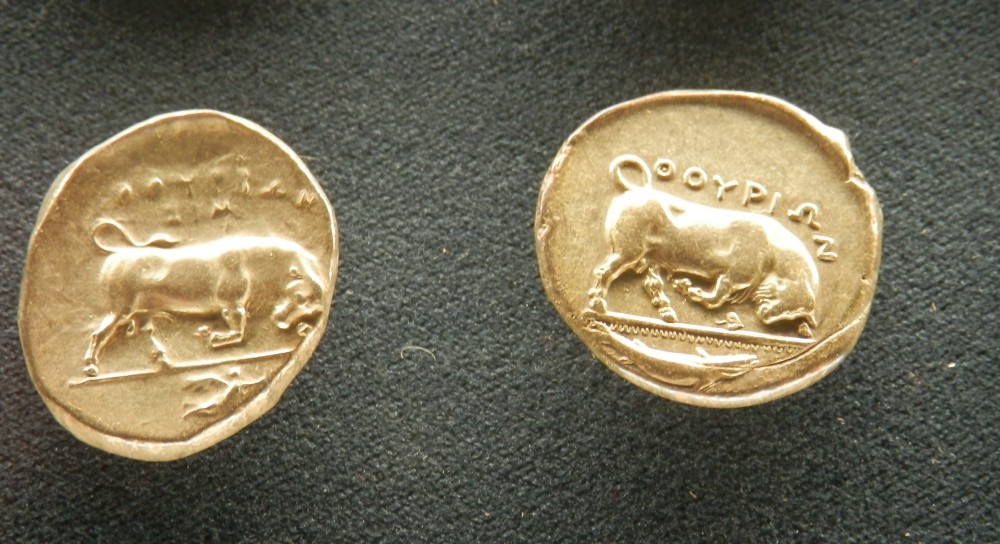
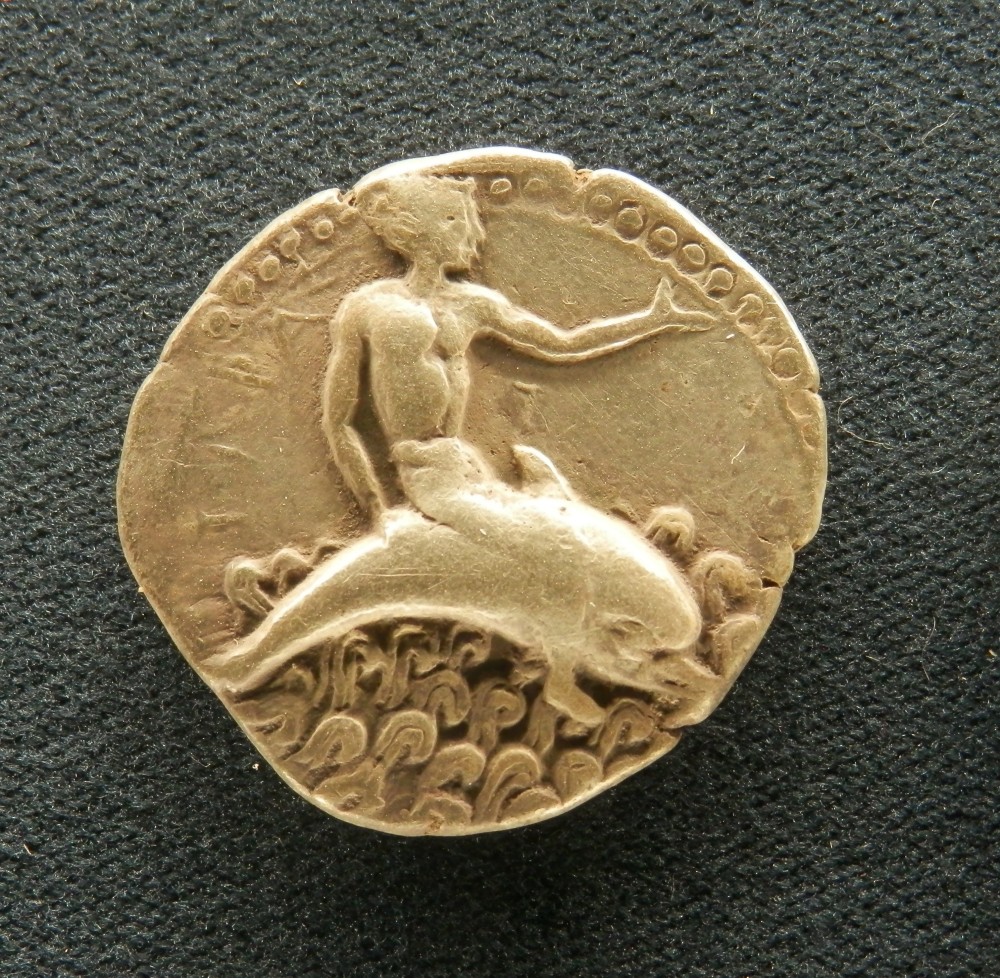
The coins in the medagliere of Siracusa inspired Dolce & Gabbana to make these shoes. I didn’t think I was all that into fashion till I saw these. I think I really need a pair. I also need the lovely belt that goes with them.
Like cities, some very rich families had their own personal coinage. Essentially, the family had its own bank, and guaranteed the currency they distributed. They had to be well known and trusted and could then also write promissory notes, and make and take loans. Each one had its own logo, which could be regarded as something like the family crest.
Some of the coins in the museum were buried in leather pouches, and in recent times found hardened into a messy lump. By some amazing methods which to me sounded like alchemy, they managed to separate them and get scores or hundreds of individual coins in perfect condition. When richer people buried a coin hoard, they sometimes placed it in a lead-lined box which prevented corrosion.
These coin hoards were often buried in times of war or political crisis, by people who planned to dig them up later, but never managed to. Some coins in the collection were excavated along with the dead bodies of wealthy people, who thought they could take it with them. Never mind their monetary value: when you see the sheer beauty of the craftsmanship in these coins, it is easy to understand why they wanted to.

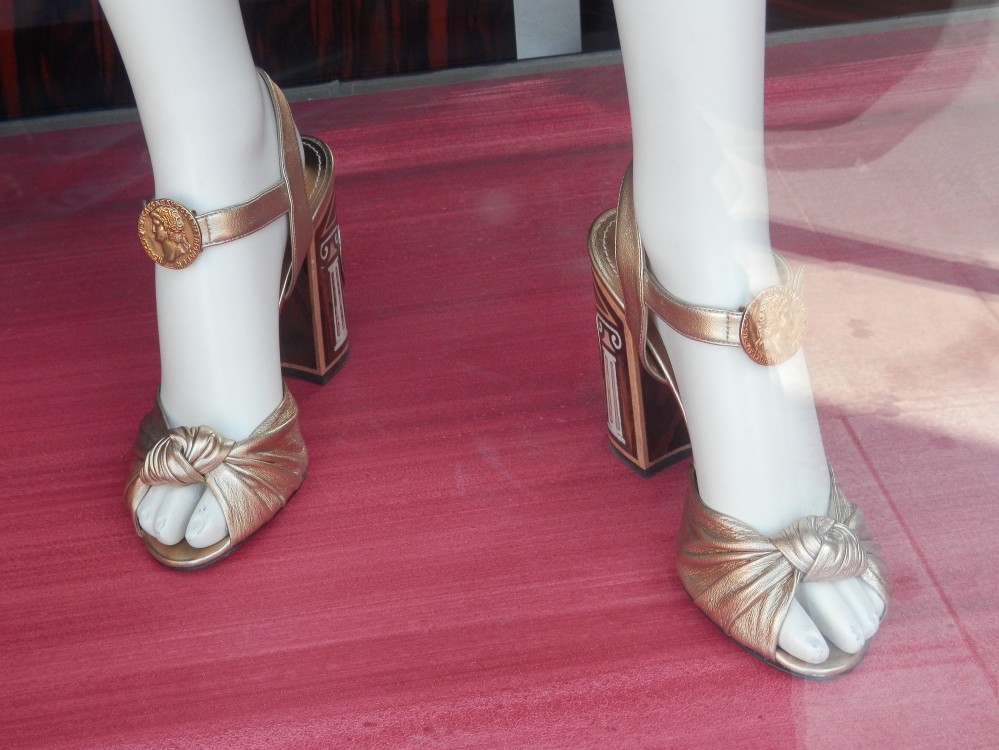
*BLING*BLING* 😉
LikeLike
… and SUPER BLING!!! 🙂
LikeLiked by 1 person
See? And I thought the jingle in your pocket was just because you like me 😋
LikeLike
😛
LikeLike
Wow, how I’ve missed your terrific posts, Veronica. Don’t ever stop writing these!
LikeLike
🙂
LikeLike
You can have the shoes, I’ll have the earrings! I also love Bulgari necklaces that incorporate old coins…
LikeLike
OK, it’s a deal! I’m with you on the Bulgari necklaces!
LikeLike
OMG so much gold and bling. Of course my favorite is the shoe 🙂
LikeLike
Yeah, same here!
LikeLike
Nice show, and coins are so valuable: They stay for thousands of years, they show pictures and text, and they allow to date an archaeological find. Coins are an archaeologist’s friend. By the way: On the coin of Arethusa, there is an interesting pendant in her ear. A jewel within a jewel, so to say.
LikeLike
Oh, very good point, I hadn’t considered how useful they are for dating sites.
I did notice her earring though. There were some in the vaults which looked a lot like that, but unfortunately my photographs didn’t work. My camera seemed to like focusing on the glass instead of the objects! 😦
LikeLike
I will take that medieval necklace please! It always amazes me what kinds of high-tech, delicate and sophisticated pieces were crafted at the same time when people were dying in their 20s because of the lack of proper sanitation.
LikeLike
The inequality of society in the past bothers me, but I think what bothers me more is that there are still so many countries like that. My brother in law is Brazilian and has made me aware of some of the truly unbelievable contrasts there are in people’s lives, living so close together divided only by wealth or poverty.
LikeLike
Well, Your site/ blog is awesome, As an American Expat in Sicily the only thing I could correct you on is how Sicilian Banks like UNicredit are in serious trouble and they stopped taking travelers checks since AMAX stopped doing business with many Italians banks. I found this out after they declared there was “No Process” to get euros from Travelers checks. I went a few rounds with the pencil necked geek and got no where. There seems to be an effort to clamp down on US currency transactions to force everyone to Euros or credit cards. No Banks will convert US currency expect at the airport and their fees are atmospherically high.
LikeLiked by 1 person
Gosh, that is worrying to hear.
Thanks for sharing the info. I will add it to the general tips page later.
Thank you for your kind comments about the website! I am glad you like it 😀
LikeLike